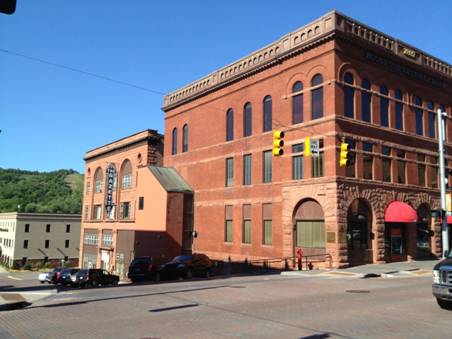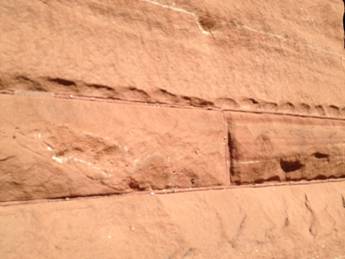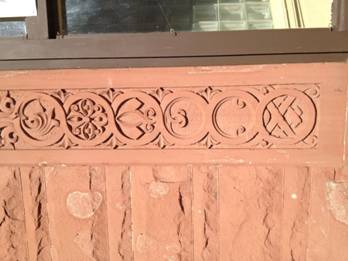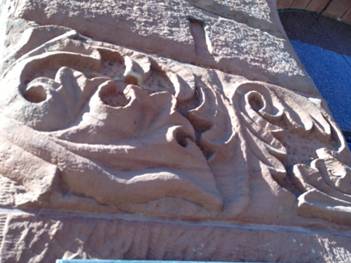 Jacobsville Sandstone Buildings
Jacobsville Sandstone Buildings
 Figure 1. Buildings made of Jacobsville Sandstone in Downtown Houghton. Photo by C. Myers
Figure 1. Buildings made of Jacobsville Sandstone in Downtown Houghton. Photo by C. Myers
Cache Summary: Jacobsville Sandstone buildings are found throughout downtown Houghton and the Upper Peninsula. These sandstones were taken from the Lake Superior region, and used as building stones throughout the UP and other places in the United States.
 Figure 2.The Gazette Building in Downtown Houghton. Photo by C. Myers
Figure 2.The Gazette Building in Downtown Houghton. Photo by C. Myers
Cache Coordinates: 47
o 7.311’N 88
o 34.012’W
EarthCache Lesson:
Why is the Jacobsville Sandstone and other sandstones considered a useful building material?
Jacobsville Sandstone
Jacobsville Sandstone is a red sandstone formation marked with light-colored streaks and spots that is exposed in the Upper Peninsula and portions of Ontario. It also can be found in the buildings throughout the Upper Peninsula and United States. The stone has had many names: redstone, brownstone, Lake Superior Sandstone, and Eastern Sandstone. Its official name, Jacobsville Sandstone, came from a quarry owner John Henry Jacobs and the city of Jacobsville, where his quarry was located. The quarries in the Upper Peninsula operated from 1870 to 1915, removing rocks from the ground and shipping them to building sites like this one in downtown Houghton.
Sandstone Properties
Sandstone is a sedimentary rock composed mostly of sand grains made of quartz and feldspar. Sandstones are formed when sands are eroded from one part of the Earth surface and then are transported by water or wind to a different location. There the sediments are deposited in layers. Overtime these sand layers are buried deep under the Earth’s surface and become slowly cemented together into hard rock. That is why you can often see layers in sandstone rocks. Sandstone can come in all sorts of colors (brown, tan, yellow, brown, red, gray, pink, white and black) the sandstone in the Upper Peninsula is mainly RED! For more information on the color of these sandstones visit the Sandstone Churches EarthCache.

Figure 3. Red Sandston Building Stones. Picture by: C. Myers
Building with Jacobsville Sandstone:
Builders used sandstones to build these buildings because it is durable, strong and relatively inexpensive. Sandstone is very resistant to extreme temperatures that can be caused by fires or cold northern winters. Though the Jacobsville sandstone is strong, the uniformity of its sand grains size and friability of its structure allow it to be easily worked into decorative features like those seen here. The combination of these characteristic make the Jacobsville an excellent material for building.
Logging Your Visit: To receive credit for your EarthCache email me your responses to the questions below.
Logging Question 1: How do you think some of the sandstone that was quarried in the Upper Peninsula was shipped?
Logging Question 2: Study the ornate designs on the buildings (like the pictures below). Do you think these where created by a mold or carved in the sandstone? How can you tell?


Figure 4. Designs found on Gazette and Wells Fargo Bank buildings. Photos by C. Myers.
_______________________________________________________________________________________________________________________
Earth Science Big Ideas:
· Big Idea 7: Humans depend on Earth for resources.
Soil, rocks, and minerals provide essential metals and other materials for agriculture, manufacturing, and building.
Looking at the buildings in downtown Houghton that using sandstone as a resource for building shows the connection between our earth and everyday civilization. The designs on the building are a way that humans use sandstone resource as a way of art.
Common Misconceptions:
· Rocks have very little practical use.
o This is a misconception because many buildings like these are made from rock like sandstone. The use of this rock was to build buildings that are durable and aesthetic.
_______________________________________________________________________________________________________________________
References:
Hunt, Mary & Don (2011). Hunts Guide to Michigan Upper Peninsula. Albion, MI: Midwestern Guides.
Regis, Robert (2012). Gifts from Nature: Older than Hills. Health and Happiness U.P. Magazine